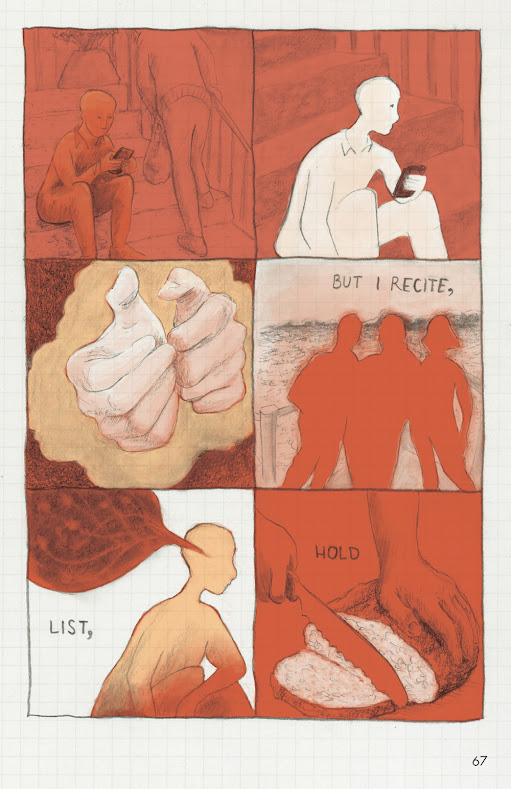POETRY COMICS ! COMICS POETRY! GRAPHIC POETRY! VISUAL POETRY! POETRY IN THE GUTTER!!
1. ANDREI MOLOTIU
Abstract Comics: The Blog [Accessed 15.02.2021]
'Abstract Comics: The Anthology edited by Andrei Molotiu is a book published by Fantagraphics (I can't buy it, TOO EXPENSIVE). Experimentation of how eyes and mind interplay between sequentiality and page layouts. The work includes practitioners of abstracted comics from Noth America, Switzerland, Great Britain, France, and New Zealand.
'Universe A': a sequence by Andrei Molotiu, who is an art historian and abstract-comics creator, looks conceptual in its style and subject. I haven't seen the entire work but these elements explore abstract comics, and 'comics poetry' layouts in the best way possible. There are no characters to explore, visual imagery explores line and texture rather than set narrative.
2. PAUL K. TUNIS
Comics Poetry – PAUL K. TUNIS [Accessed 17.02.2021]
One of the contributors and co-founders to INK BRICK magazine about 'comics poetry'. The magazine stopped being published a few years ago, but its archive presents a great variety in ideas and styles on 'comics poetry'.
Sections from 'Polydactyl'. This work termed 'comics poetry' has as many interpretations as practitioners who explore it. This work is illustrative, but bridging other areas and disciplines like fine art.
3. ALEXANDER ROTHAM
What Is Comics Poetry: An Essay By Alexander Rothman, Editor-In-Chief of INK BRICK - Comics Bulletin [Accessed 17.02.21]
Alexander Rothman | Comics Poetry (versequential.com)
connotative meanings (associated meaning)
(Art Books – Fantagraphics - interesting book publisher.)
4. Tamryn Bennett
About — Tamryn Bennett [Accessed 18.02.21]
Comics Poetry: Praxis and Pedagogy (ufl.edu) [Accessed 18.02.21]
Comics Poetry: The Art of the Possible | Cordite Poetry Review [Accessed 18.02.2021]
Recognizes spatial and temporal potential for poetry. Verbal-visual experimentations have a rich, often neglected, tradition in the history of the written word.
Both poetry and comics share similar visual-verbal structures:
- typographic experimentation
- symbolism
- spatial arrangements of stanzas and panels
- page layouts
-rhythm
Concrete poetry, or poetry in general, doesn't share panels, gutters and speech balloons. So to speak, to call a work graphic poetry- comics poetry, all the above characteristics have to present with the work.
DISJUNCTIVE - lacking connection or consistency.
Segmentivity apprehends strategies of poetry:
- gaps
- anacoluthon - syntactical inconsistency or incoherence with a sentence, especially: a shift in an unfinished sentence from one syntactic construction to another (as in "you really ought-well, do it your own way")
- fragmentation - a part broken off, something cut or detached from the whole, something imperfect
- juxtaposition
poly-sequential possibilities / multi-linear associations
Interview with Rachel Blau DuPlessis (RBD)’ in Comics Poetry: Beyond Sequential Boundaries (Thesis). Sydney: University of New South Wales. 2012. Print.
5. INK BRICK the JOURNAL of COMICS POETRY
INK BRICK | The Journal of Comics Poetry | Special Issue by Ink Brick Kickstarter
[Accessed 21.02.21]
INK BRICK: Archive shows a great array of participants, styles, ideas, and interpretations of 'comics poetry'. The work is often disjointed from traditional modular comics strip without speech balloons (although they do appear as well), with or without panels, gutters, traditional layouts, etc. The Archive also researches the work from the past (Breinards 1965, Caza 1940) to show that experimentations with comics as an art form have a long and often neglected history.



























Comments
Post a Comment